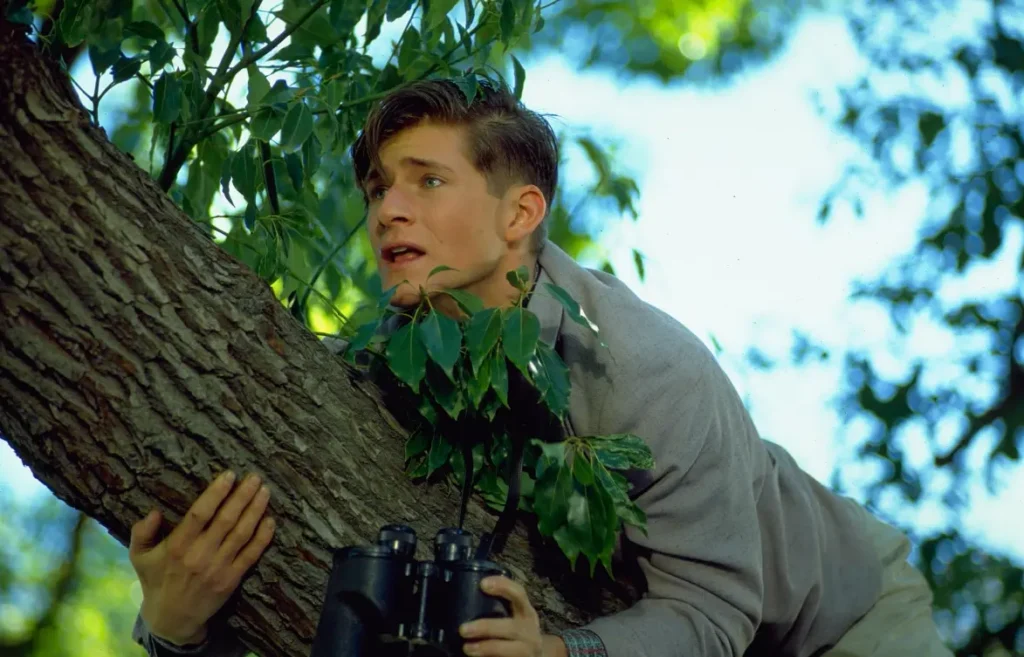One of the most fascinating things about life is how little we know about our parents before we came along. They tell us stories—some exaggerated, others too neat—but can we ever truly imagine their younger selves? Back to the Future (1985) takes this curiosity and spins it into a wildly entertaining sci-fi adventure that asks: What if you could meet your parents as teenagers? And better yet, what if you could change their lives—and yours—in the process?
The story kicks off in the 1980s, a world of neon signs, Walkmans, and shoulder pads. Marty McFly, played with boyish charm by Michael J. Fox, is your average teenager dealing with life’s everyday chaos. His dad, George (Crispin Glover), is the embodiment of awkwardness, while his mom, Lorraine (Lea Thompson), has traded her youthful dreams for a glass of wine at dinner. Marty loves them but also can’t help but feel trapped by their humdrum existence.

Enter Doc Brown. Christopher Lloyd’s portrayal of the wild-haired, eccentric inventor is nothing short of iconic. Doc’s latest invention? A time machine built into a DeLorean—a sleek, futuristic car turned scientific marvel. In a burst of sparks and plutonium-fueled energy, Marty finds himself launched 30 years into the past, arriving in 1955 when his parents were teenagers.
Now, let’s pause here for a second. Imagine walking into your high school cafeteria and spotting your mom and dad—not as the authority figures you know but as kids, just like you. It’s both hilarious and unsettling. For Marty, it’s all that and more because, in a twist that could only happen in a time-travel comedy, his mom develops a crush on him. Yes, that kind of crush.
But the movie isn’t just about the awkward laughs—it’s about fixing the timeline. Marty’s presence disrupts the fateful meeting between his parents, threatening his very existence. To set things right, he must play matchmaker while navigating the quirks of 1950s small-town life. And he’s on a tight deadline because, as Doc explains, the only way to power the time machine and return to 1985 is a bolt of lightning—and they know exactly when and where one will strike.
What makes Back to the Future so magical isn’t just the time-travel hijinks or the witty dialogue. It’s the heart. Watching George McFly transform from a stammering pushover to someone who can stand up for himself feels like a victory not just for Marty but for everyone rooting for the underdog. Meanwhile, Lorraine’s youthful glow reminds us that our parents were once just like us—filled with dreams, insecurities, and the occasional misstep.
The film also excels at playing with contrasts. The 1980s and 1950s settings are as different as day and night, and director Robert Zemeckis mines that for both comedy and insight. For example, Marty’s 1980s slang and fashion turn heads in 1955, with one diner owner even asking if he’s part of the Coast Guard because of his “life preserver” (a.k.a. his puffy vest).
And then there’s the DeLorean—a character in its own right. Sleek, shiny, and powered by science-fiction magic, it’s as much a star of the movie as Marty and Doc. When it hits 88 mph and those glowing light trails appear, you can’t help but feel the rush of adventure.
But beneath all the fun and frenzy, Back to the Future carries a profound message. It’s about choices—the ones we make, the ones our parents made, and how they ripple through time. Marty doesn’t just help his parents fall in love; he inspires them to be better versions of themselves, and in doing so, he changes his own life for the better.
Robert Zemeckis directs with a light touch and a sense of wonder reminiscent of Frank Capra’s classics. The movie feels less like traditional sci-fi and more like a magical tale about family, destiny, and second chances. It’s no surprise that Steven Spielberg, the executive producer, had a hand in bringing this to life. His knack for blending heart and spectacle is all over this film.
Back to the Future is also a visual treat. From the retro diner to the iconic clock tower, every set piece is designed to transport you. Alan Silvestri’s rousing score pulls you further into this whirlwind journey, and Huey Lewis and the News’ “The Power of Love” is the perfect anthem for Marty’s adventure.
So why does this movie still resonate nearly 40 years later? Perhaps because it’s about more than time travel. It’s about discovering that the past, no matter how messy, holds the keys to our future. It’s about realizing that our parents—flaws, quirks, and all—once had to navigate the same tricky terrain we do. And most of all, it’s about hope: the hope that we can all learn, grow, and maybe even get a second chance to make things right.
If you haven’t watched Back to the Future yet, what are you waiting for? Whether you’re a fan of sci-fi, comedy, or heartfelt storytelling, this is a ride worth taking.
Keywords: The Goonies full review, iconic ’80s movies, must-watch family adventures, sci-fi comedies with heart, classic time-travel films, Marty McFly and Doc Brown adventures, why watch Back to the Future.


